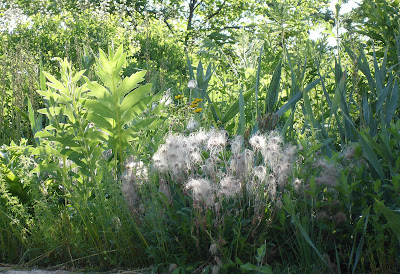
Sunrise 5:16 am on the longest day of the year, but the sun will not reach the garden until well after six. When the light reaches the meadow, the leaves of Silphium laciniatum (Compass Plant) are backlit, emphasizing its deeply-cut leaves that look like large hands reaching toward the sky. In the foreground, a pink cloud of Geum triflorum (Prairie Smoke) catches the light as it filters through the trees that form a canopy over the Dark Plate (Robinia pseudoacacia 'Chicago Blues').

On today's garden tours, some of the highlighted plants include Monarda bradburyana (Eastern Bee Balm). This pale pink bee balm was planted last fall in the Light Plate. It makes a nice companion to the deep violet Allium purpurea (Ornamental Onion) that is interplanted with it. Look for both of these plants coming through a ground cover of a young ornamental grass, Sporobolis heterolepis 'Tara' (Prairie Dropseed).

In the Light Plate, growing near the Monarda and Ornamental onions, Stachys officinalis 'Hummelo' (Betony or Hedgenettle) is beginning to open. This plant was developed by plantsman Piet Oudolf at Hummelo, his garden and nursery in the Netherlands. Oudolf uses this plant in the Lurie Garden because of its deep violet orchid-like flowers that are compactly borne on flower spikes. It attracts all types of insects while in bloom and when dry, its silhouette gives interest to the winter garden.
Small garden signs will direct you to other plants in bloom that include: Echinacea purpurea 'Rubinglow' a deep pink coneflower that is just beginning to show; Phlomis tuberosa 'Amazone' (Phlomis) a tall plant with pink flowers clustered around the stem; Sanguisorba menziesii (Burnett) with red knot-like flowers and toothed leaves, growning near the stairs at the Seam.

No comments:
Post a Comment